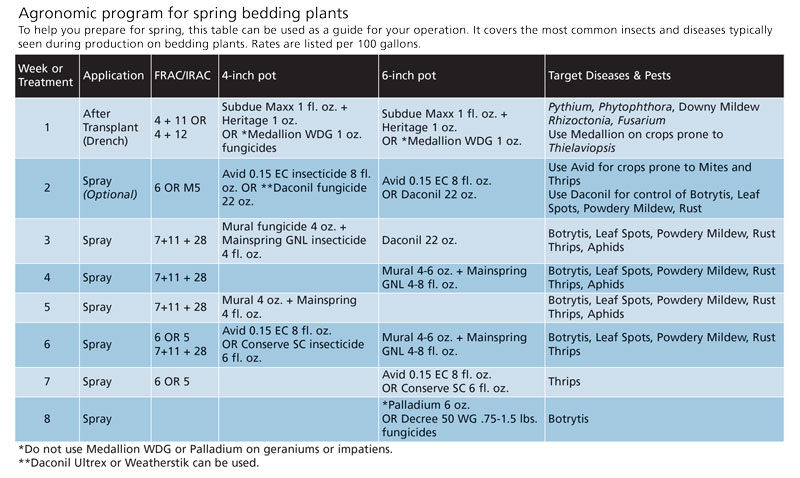12/1/2018
Planning for a Successful Spring
Nancy Rechcigl
As one door closes, another opens. The same can be said for ornamental production. As we close the door on 2018, it’s almost time to open it again for the 2019 bedding plant season. One of the busiest times of year, spring production can also be the most difficult, particularly because of the variety of plant material in production. Ensuring your crops are protected from propagation to shipping is essential for a successful season. Being prepared is critical and can help limit insect or disease surprises.
A programmatic approach
One way you can prepare for spring is by using an agronomic program as a part of your overall production plan. An agronomic program is a comprehensive plan that focuses on preventing problems due to diseases and insects a crop may encounter. For example, geraniums are notorious for having Botrytis and occasionally rust; you would want to include a proven solution for these problems in your program.
Proactively scouting for the problems you anticipate (and finding some that you don’t) and having an action plan will help reduce outbreaks and plant injury, ensuring the production of a high-quality crop. Battling a disease or pest outbreak is often more costly, requiring more curative applications and labor time.
An important feature of a well-researched program is a built-in resistance management strategy that incorporates three or more products with different modes of action (MOA). Rotating different modes of action is particularly crucial to help avoid resistance. A well-structured program will consider how best to utilize the products’ strengths and leverage modes of action at times when they’ll provide the maximum benefit.
Follow the steps below to create a program fit for your operation:
• Identify the primary disease and insect problems that can affect each crop
• Select two to three products with different MOA classifications that have proven activity on each disease or insect
• Position these products in the program based on their features, such as:
Systemic, translaminar or contact activity
Length of control
Regulatory requirements (REI, PPE, use limits)
• Rotate among these products based on label recommendations
• Keep good records for future crops including scouting finds and treatments that worked well
Cultural practices
Employing good cultural practices is critically important to prevent the development and spread of disease and insect problems. High humidity levels, prolonged leaf and media wetness, and lack of sanitation practices can cause diseases to quickly establish and spread through your operation. Weeds and algae left under the benches and in the production area can harbor pests that are waiting to invade the next crop.
Here are some helpful tips to prepare your operation for spring production:
• Sanitation: Remove crop debris and weeds daily. If you put them in a bin, make sure it’s tightly sealed in case there are already insects or pathogens present.
• Ventilation: As temperatures increase, it’s especially important to have good air flow in your greenhouse. Keep fans running to eliminate warm or cooler areas.
• Plant spacing: Ensure plants aren’t too close together as they grow. This also will help with air flow and prevent insects from moving as quickly between crops.
• Watering: Many pathogens thrive when leaves are wet for more than a few hours. Water early in the day so the plants can dry out faster. Avoid overhead watering if possible.
A well-rounded plan
Implementing a well-researched rotation program and maintaining appropriate cultural practices can lead the way to a successful spring season. Preventing the onset of diseases and insects early can help ensure your ornamental crops are in top shape from shipping and beyond.
Download pre-developed agronomic programs for greenhouses and nurseries by visiting www.GreenCastOnline.com/Solutions. GT

Nancy Rechcigl is Technical Services Manager for Syngenta.